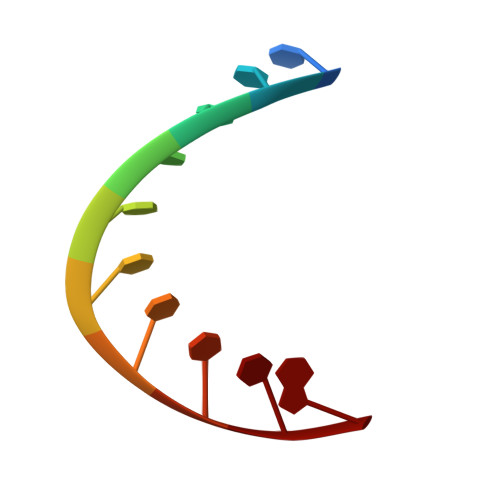An unusual sugar conformation in the structure of an RNA/DNA decamer of the polypurine tract may affect recognition by RNase H.
Kopka, M.L., Lavelle, L., Han, G.W., Ng, H.L., Dickerson, R.E.(2003) J Mol Biol 334: 653-665
- PubMed: 14636594
- DOI: https://doi.org/10.1016/j.jmb.2003.09.057
- Primary Citation of Related Structures:
1PJG, 1PJO - PubMed Abstract:
Retroviral conversion of single-stranded RNA into double-stranded DNA requires priming for each strand. While host cellular t-RNA serves as primer for the first strand, the viral polypurine tract (PPT) is primer for the second. Therefore, polypurine tracts of retroviruses are essential for viral replication by reverse transcriptase (RT). These purine tracts are resistant to cleavage during first strand synthesis. In obtaining the primer for second strand synthesis, the RNase H function of RT must cleave the PPT exactly for in vivo transcription to proceed efficiently and proper integration to occur. At the RNase H active site the protein makes contacts primarily along the backbone, with hydrogen bonds to the sugar-phosphate oxygen atoms. A high-resolution structure (1.10A) of the first ten base-pairs of the RNA/DNA hybrid PPT, r-(c-a-a-a-g-a-a-a-a-g)/d-(C-T-T-T-T-C-T-T-T-G), contains the highly deformable r-(a-g-a) steps found in retroviral polypurine tracts. This r-(a-g-a) motif is utilized in the "unzipping" or unpairing of bases that occurs when RT binds a malleable PPT. Another unusual feature found in our high-resolution PPT structure is the sugar switch at RNA adenine 2. All the RNA sugars are the expected C3'-endo, except sugar 2, which is C2'-endo, characteristic of B-form sugars. This local A-to-B conversion adversely affects the pattern of hydrogen bonds from protein to sugar-phosphate backbone, disrupting the catalytic site. Disruption could cause the enzyme to pause at the 5'-end of the PPT, leaving it intact. Pyrimidine-purine (YR) steps are most deformable and the T-A step especially can undergo A-to-B transitions readily.
Organizational Affiliation:
Molecular Biology Institute, University of California, Los Angeles, CA 90095-1570, USA. kopka@mbi.ucla.edu
















